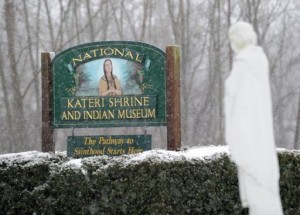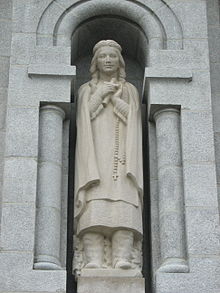









Gallery |
Passions Grow Over First Native American SaintBy Sebastian Smith (AFP) – January 17, 2012 FONDA, New York — Gazing down a frozen New York field, the statue of a Mohawk girl about to become the first Native American saint exudes calm. Yet the real Kateri Tekakwitha had a brutal existence — and ghosts from her dramatic life still haunt these hills. The 17th-century figure will make history when the Vatican canonizes her later this year, although the joy among America’s indigenous tribes will be mixed with some painful historical memories.  Kateri Tekakwitha will become the first Native American saint in the Catholic church (AFP/File, Stan Honda) No other “Indian”, as the original inhabitants of the United States and Canada are widely, but wrongly, called, has made sainthood. Following centuries of being dispossessed, caricatured, or ignored, Native Americans will soon have the unusual experience of appearing in a positive light. Mark Steed, the Franciscan friar heading the Kateri Shrine on the banks of the Mohawk River, said that after more than 30 years of working among Native Americans, he is happy to see them win this boost. “They were put down, bypassed,” Friar Mark, a soft-spoken but steely tough 71-year-old, said. “So I think when you have a repressed people, any star in their crown is a plus.” For many Native Americans, especially among the Mohawk and other Iroquois tribes straddling the US-Canadian border, Kateri’s sainthood was overdue decades ago. The Vatican needed a certified miracle from the three-centuries-dead tribeswoman and so followers submitted reports of dozens: everything from healing the sick to levitating a man off the ground and appearing herself, hovering in deerskin clothes. None of these passed muster. But then in 2006 doctors in Seattle confirmed an astonishing event. Against all medical expectations, an 11-year-old Native American boy fatally ill with a flesh-eating bacteria made a full recovery. His parents had been praying to Kateri. Although needing another five years, this one convinced the Vatican, and last month Pope Benedict XVI cleared Kateri for canonization. Her followers may not have a date yet, but they are already excited. “It will be a celebration of first magnitude,” proclaims the January issue of the shrine’s Tekakwitha News. Kateri’s life story encompasses the despair and — for some — the hope sown in those tumultuous early years of the white settlers. According to Jesuit accounts and oral history, Kateri survived a settler-introduced smallpox epidemic at four, but was left orphaned and near-blind. The next calamity was a raid by French settlers and native allies who burned her village to the ground. Again she survived, spending the next decade in a newly built village across the Mohawk River in the woods near today’s Kateri Shrine. It was here, when she was about 20, that she was baptized and entered the crucial last four years of her life. Ostracized by her tribe, Kateri — whose native name Tekakwitha translates as “The Clumsy One” — fled to a village of converts in what is now Canada. Despite being ravaged by illness, she tended to other sick and lived a life of extreme asceticism — including burning herself with hot coals — that attracted admiration from missionaries and converts alike. Tradition has it that when she died, aged 24, her smallpox-scarred face suddenly cleared. That story still inspires people around Fonda to gather in the shrine’s open-air chapel in summer, or in the 230-year-old wooden barn housing a chapel where a large painting of Kateri hangs behind the altar. But intertwined is the dark history of European conquest and the role played by Christian conversions. Tom Porter, who lives a short drive down the road from the Kateri Shrine, believes Kateri unwittingly contributed to the destruction of her people. “She was used,” he said in a rare interview.  Statue of Kateri Tekakwitha by Joseph-Émile Brunet at the Basilica of Sainte-Anne-de-Beaupré, near Quebec City. Unlike many modern Mohawks who have either converted or are not interested in any religion, Porter works actively to restore the old beliefs. He lives with family and a handful of followers on a farm where they grow their own crops, raise cattle and use work horses to plow the earth. A longtime Mohawk acting chief, Porter is immersed in the spiritual ways of his forefathers. Inviting a reporter to join a huge family meal in the compound’s main house, Porter, whose native name is Sakokwenionkwas, or “He Who Wins”, said the moon, the sun and thunder are more important to the Iroquois than saints or popes. “Christianity is not a shoe that will ever fit. Not for my feet, or my heart, or my soul,” he said. A humorous man, Porter carries echoes in his face of the proud, eagle-like features seen in old pictures of tribesmen. But he could not conceal his bitterness. To him, there is no difference between the spread of Christianity and the cruel policies, including forced assimilation in grim 20th-century government boarding schools, that were used to subjugate Native Americans. Aged 67, Porter has made sure every one of his five daughters, one son, and 11 grandchildren follows the traditional ways. He thinks Kateri was probably forced to become a Catholic. “I don’t know if she really was a Christian or not,” he said. “They were in poverty at that time. The Europeans had destroyed everything, people were destitute and starving, and if you wanted to get help of any kind you had to be a Christian.” Porter conceded that few Mohawk agree with him. He even admitted that some in his extended family are devoted to Kateri. “It breaks my heart,” he said. Friar Mark acknowledged that there had been “terrible” sins and was determined to heal the wounds. In the wooden chapel at the Kateri Shrine, a native blanket covers the altar. Snowshoes and deerskins hang from the rafters, and sacred herbs like tobacco and sage lie drying. There’s a crucifix, of course, but also a picture of the tree and turtle at the center of the Native American creation legend. Soon after taking up his position in Fonda a year ago, the tall Canadian friar went to call on Porter. “He was amazed,” Friar Mark recalled. Since then, the two have met often and while they don’t agree, they listen to one another, an odd couple making peace on the spot where a future saint once lived. “He’s a friend,” Porter said of Friar Mark. “When I was growing up, there was no one who hated priests and nuns more than I did. But I got over that now. All my enemies — they became my good friends.” More links: USA Today, About.com, Wikipedia
Church to be Demolished to Expand StoreWNYT-TV, Albany, NY – 07/20/2010 – Subrina DhammiFonda, NY – For the first time in about 170 years, there will no longer be a place of worship at 42 W. Main Street in Fonda. In 1842, a group of methodists built a small wooden church at that address. It was so popular, they had to expand a year later. “Then on April 12th, 1912 there was a fire that started in the drug store next door,” said Fultonville Village Historian, Ryan Weitz. He’s also the unofficial Historian for the village of Fonda. Weitz is putting together a piece on the history of the old church. At 18 years old, he’s the youngest Historian in New York State. He was appointed to the position when he was 15 years old. After the fire, Weitz says the church was built again, this time it was brick. The building was vacant from 1967 to about 1986, when the Village Bible Church bought it. Then in 2005, the House of Zion moved in. Today, the stained glass windows on the historic structure are gone. Tarps flap in the wind, covering the openings. The doors are locked. And the sign displayed, letting everyone know what kind of church this is, is gone. On Monday, the entire building is expected to come down. “It’s a shame to see an old building like this be torn down for the expansion of a gas station and small convenience store,” said Weitz. The Stewart’s store two doors down at 38 W. Main street is often congested. The parking lot is small and gas pumps cramped. Stewart’s approached the land owners of 40 W. Main Street, and 42 W. Main Street, which is where the church is located. Both agreed to sell the land. The most recent congregation at the old church, was Messianic Christianity, lead by Pastors Richard and Denise Allen. For the past five years, they’ve rented the building. “It’s such a beautiful building, and it still had some life left in it,” said Pastor Denise Allen. Messianic Christianity combines the teachings of both Christianity and Judaism. “We had 3 pastors ordained as Messianic Rabbis in that building, and that’s historic,” said Pastor Allen. She will continue to hold services at a church she built on her property at 580 Dillenbeck Road in Palatine Bridge. The small white building has a blue border, and the letters are decorated with glitter. Flowers surround the entrance. No more than 30 people can fit inside the church at one time. “Some people say gee, we never met anyone like you, I say thank God, it’s ok to be different.” If you want to find out more about Pastor Denise Allen’s church, email her at Deniseallen01@aol.com |